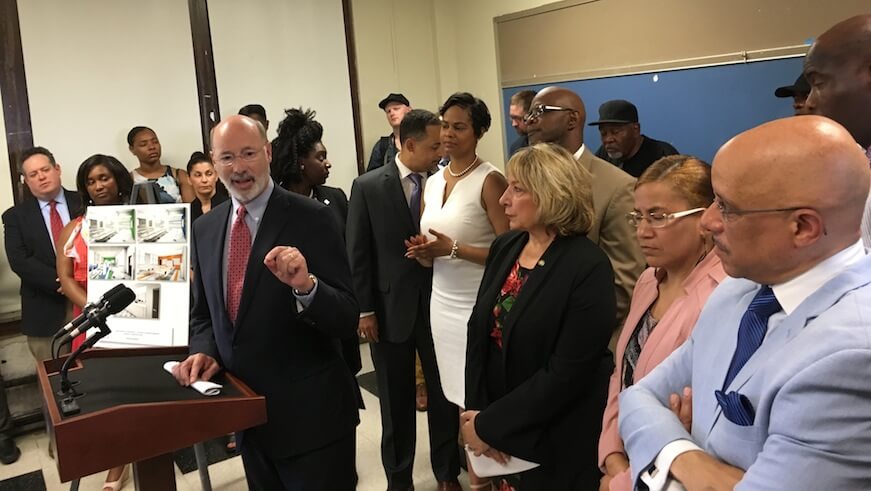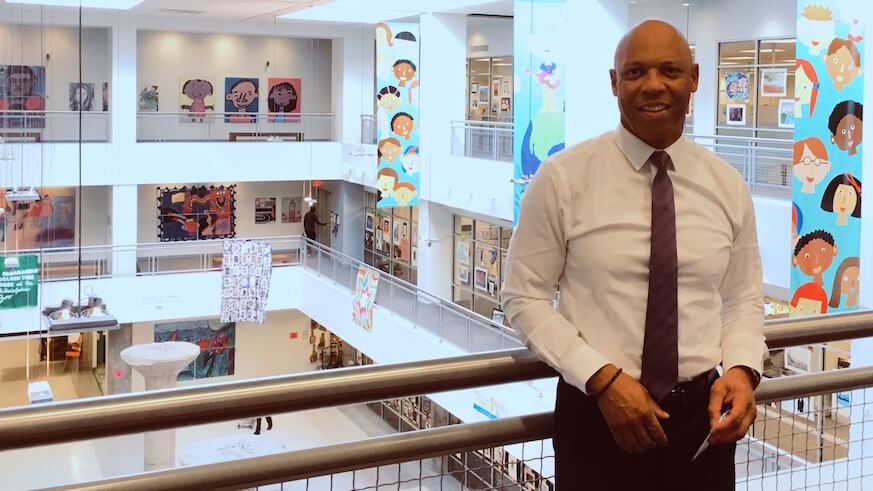The School District of Philadelphia has seen a lot of changes lately. But for students and teachers, one of the biggest is that school starts in August. The 2018-19 academic year begins Monday, Aug. 27, a week earlier than usual for Philly Schools.
School District of Philadelphia superintendent Dr. William Hite said the change, planned for two years, will make the transition back from summer easier for students at Philly schools.
“We wanted to actually start with a full week of school before then going to all of the holidays,” Hite told Metro, noting that Labor Day and other holidays are dotted through the first weeks of September. “Sometimes we would go three, maybe four weeks of school before there was a full week of school. … It throws you out of rhythm, and you don’t feel like you’re into the school year until mid-October.”
Dr. Hite has been putting the word out about the early start with the #RingtheBellPHL campaign, with people like Mayor Kenney, Phillies left-fielder Rhys Hoskins, and other school staff and city agencies chiming in on social media.
The calendar change will also let schools front-load instructional time earlier ahead of standardized tests, Hite said. Students will get a two-week grace period to get their school uniforms together to compensate for the earlier start.
Given a climate analysis shows the last week of August and first week of September have roughly equal temperatures, it won’t make a big difference for students at Philly Schools, Hite hopes – and the benefit is school will end earlier, with the last day of the school year currently set for Tuesday, June 4, 2019.
To participate in #RingtheBellPHL, everyone across Philadelphia is being invited to ring a bell at 8 a.m. on Aug. 27 to signal the start of the new school year. You can let your bell’s ring fill the air, or make a video and post it on social media, tagged #RingtheBellPHL.
Massive summer clean-up of lead, asbestos
One challenge this summer has been the conditions of school buildings, which came under intense public scrutiny earlier this year after the Philadelphia Inquirer’s “Toxic City” series reported on environmental hazards like lead, mold and asbestos in some facilities – which over time can cause serious health issues.
To address the issues, the District spent $8 million on an accelerated cleaning program over the summer, bolstered by $7.6 million in funding brought in by Pennsylvania Gov. Tom Wolf and other state leaders.

The summer clean-up was truly massive: 1,200 maintenance staff and contractors worked on the project. More than 100 painters worked on 22,000 square feet of damaged paint and plaster in 168 rooms at Philly schools like Finletter, Logan, Emlen, AS Jenks, Barton, and Kirkbride schools to stabilize lead paint. That work will continue at 38 schools. Daily inspections are scheduled to look for debris and dust, which will be removed with a HEPA vaccum.
To address air quality, 123 unit ventilators and 18 air handlers at the J.B. Kelly and Hon. Luis Munoz-Marin schools were installed, 2,000 feet of pipes at J.B. Kelly were replaced, and Munoz-Marin got new ducts installed, all as part of a $5.6 million HVAC upgrade.
Asbestos abatement work was done at A.S. Jenks, Cassidy, H.A. Brown, Olney, Mifflin and Nebinger, with work at J. Hampton Moore School scheduled over the last weekend before schools starts.
Additionally, 163 pre-K to 3rd grade classrooms were modernized across 11 Phillly schools as part of a $20 million year investment at the following schools: J.H. Brown, George Childs, Anna B. Day, Louis Farrell, William Hunter, Morton McMichael, J. Rhoads, William Rowen, Steel, John Taggart and John Webster.
Staff at 32BJ District 1201 collaborated on new cleaning guidelines for daily protocols.
“We have worked all summer to ensure that facilities are ready to receive children,” Hite said. “We’ve been addressing the facilities that were the highest priorities, and this work is work that will continue throughout the school year.”
Hite acknowledged more work is needed, as was pointed out by Jerry Roseman, director of environmental science at the Philadelphia Federation of Teachers’ Health and Welfare Fund. “One of the complications of an early start date is that there has been less time to address these areas as effectively as we’d like,” Roseman said. “Failing air conditioning systems, and the resultant mold growth, is especially problematic and concerning.”
State sen. Vincent Hughes, who lobbied to get the state funding, said more funding is needed state-wide to address these issues.
“The public school infrastructure, the crumbling, toxic buildings, are the most vivid picture of the unequal funding of our public schools,” Hughes said. “I think families should trust, but verify. Families should be aggressive about asking the question, ‘Is my school building safe?'”
Hite acknowledged the scale of problems across the District’s aged facilities, and asserted they would continue working on it until every environmental issue is addressed. But they will have to seek an increase in the District’s budget to accomplish that.
“While our funding picture is brighter, it’s still inadequate for our school district given the condition of our buildings and the challenges that our children come to school with,” Hite said.
Philly schools now under local control
The earlier start date isn’t the only major change at the School District this summer. After 17 years of state control, the School Reform Commission (SRC) agreed to dissolve itself over the summer. Governance of the School District of Philadelphia has been under local control since the new Philadelphia Board of Education took over on July 1. This change means a new opportunity for the public to get involved in how schools are operated, Hite said.
“It is now a responsibility of the citizenry of Philadelphia, and we want the citizenry to get involved,” Hite said.
The SRC’s dissolution was prompted by milestones like the District bringing its $3 billion budget into balance, finalizing a new contract with teachers, and achieving growth in students’ graduation, attendance and literacy rates.
“The credit goes to everybody who sacrificed in order to get us to the place where we are,” Hite said of these steps. “We had teachers who were without materials, children who were without programs, we had schools without nurses and counselors. … We navigated through that, but it’s really important as we move to local control, that we don’t fall back into a scenario where we’re talking about ‘What do we cut?’ … That can’t be how we approach this work.”





























